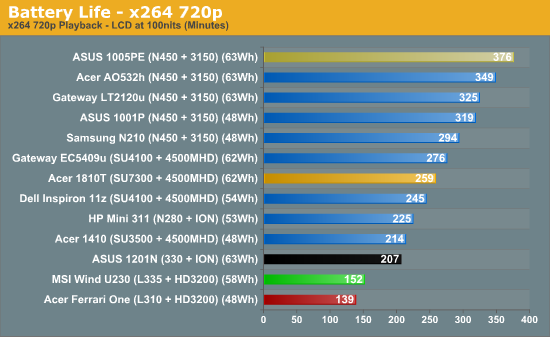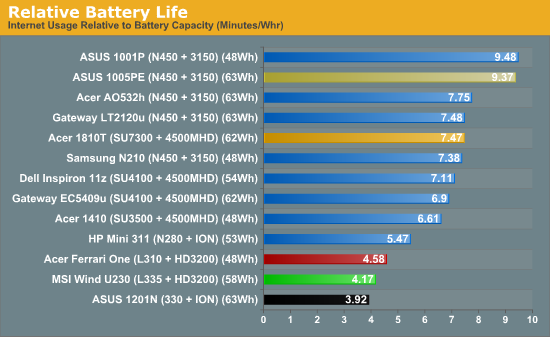MSI Wind U230: One Last Hurrah for the AMD Athlon Neo X2 Congo
by Dustin Sklavos on August 4, 2010 7:00 PM EST- Posted in
- Laptops
- AMD
- MSI
- U230
- Athlon Neo X2
Battery Life and a Wrinkle or Two
Unfortunately, the improved performance of the L335 exacts its price in blood. Specifically, the blood of your battery.




It's pretty dismal. A machine this small begs to be off the chain, but here AMD's power-hungry Congo platform makes its presence known, ensuring a useful lifetime on the battery of a shade over three hours. That's about enough to get through one lecture in a class, but it's inexcusable for a machine that's otherwise so small. And when 720p playback is brought into the picture, battery life dips under three hours.
What's interesting, however, is discovering how AMD handles their power savings on the Athlon Neo X2 L335. Simply put, they don't. While researching this notebook and others that use Athlon Neo processors, many other users have tried to squeeze more battery life out of AMD's hardware and met with some success. That success stems from undervolting the processor using RMClock, and it's actually pretty effective at adding a good half hour or so to the battery.
A major part of the problem seems to be that AMD volts the Athlon Neo X2 extremely aggressively. Our review unit has a standard voltage of one volt on the processor, and that voltage is consistent regardless of the clock speed the chip is running at. That means that whether the chip is running at full tilt 1.6 GHz or the more "power economical" 800 MHz, it has the exact same amount of voltage coursing through it, throwing heat and spinning up the fan.
Using a combination of RMClock and IntelBurnTest, we were able to bring the voltage of the processor at 1.6 GHz down to just .825V, a substantial .175V difference, and at each multiplier step we were further able to reduce the voltage of the chip by at least .025V. It's a major improvement; when testing stability at 1.3 GHz with a voltage of .75V using the gruelling IntelBurnTest, we found the system fan barely span up more than its usual hum and certainly didn't get anywhere near as loud as it did at the full volt. If anything it's a shame the chips don't ship better tuned from the factory, because they're clearly capable of performing at least a little better and a little more efficiently.










32 Comments
View All Comments
arthur449 - Wednesday, August 4, 2010 - link
I must say, that keyboard layout *is* quite nice. I'd love to see that on more ultraportable laptops.jeremyshaw - Wednesday, August 4, 2010 - link
I agree, however, it's called "one last hurrah" for a good reason. Even though I am not a vendor, I am speculating the low voltage Nile K10.5 CPU aren't in mass numbers, yet. We now AMD has made one massive push into this market, with over 100 new laptop designs produced, but I have yet to see their delivery numbers truely slide into view.JarredWalton - Wednesday, August 4, 2010 - link
What I don't get is why Dell seems to have the most compelling Nile offering on the planet, and then they go and make a UK/Europe part! You can get a nicely equipped model for £579, but that's with VAT (17.5%) and shipping, and prices in the UK tend to be higher anyway. Seems like the US price should be able to get down to ~$600, which should be pretty good for the K625 model.futurepastnow - Wednesday, August 4, 2010 - link
I suspect the cheaper model with MV-40 will still handily outperform any Atom netbook.JarredWalton - Wednesday, August 4, 2010 - link
That's like beating a 5-year-old in an arm wrestling match. :pI've used an MV-40 notebook (also from MSI, only with an HD 4330), and while faster than Atom it's still sluggish at far too many tasks. The 4330 was a waste, really.
anactoraaron - Wednesday, August 4, 2010 - link
Expecially considering you can drop $500 on an ASUS UL-50 refurb with 210M and Optimus.http://www.newegg.com/Product/Product.aspx?Item=N8...
I mean, yeah, it's a refurb... but if I was spending $500 on almost outdated tech this is the route I would go...
Shadowmaster625 - Thursday, August 5, 2010 - link
This review is pointless, and it is obvious that reviews of old AMD products are placed on this site merely as filler. Why even bother? Change name to IntelTech.maniac5999 - Thursday, August 5, 2010 - link
Actually, I've owned a U230 for about 6 months. (bought it at the same price it is today) and while I do agree that it is a little unfair to review a product right at the end of it's product cycle, Anandtech can only review products that are sent to them. (alrhough I'm still waiting for the K10.5 Toshiba review that they promised they'd have up in a week, when they reviewed the old M600 one a month ago)Personally I think that the review is pretty much spot on, It's a great machine with bad battery life. I use my notebook for basic internet surfing and document creation, as well as time-killing with games. Civ IV and WoW run great on it, and it can even struggle through Starcraft 2. Something SLIGHTLY more powerful (both CPU and GPU) with double the battery life in the same case would be ideal. (to be honest, the U230 is very small for a 12" notebook, most 12" notebooks are at least 1/2" larger on every size.
Because of this I'm really looking foward to Bobcat. Intel can't make a decent GPU to save their life (Look how old the 3200 is and how it's STILL at as good as intel's top of the line desktop IGP) and Nvidia seems to only want to make discrete graphics for netbooks in this size range. Unless Nvidia releases Ion 2 for 12" i series CULVs, AMD's still going to be the only game in town. (Disagree? point me at any other 12" laptop that'll play Starcraft 2)
maniac5999 - Thursday, August 5, 2010 - link
EDIT: No, the Alienware M11 doesn't count, it's a 14" laptop with an 11" screen. 4.5lbs is HEAVYJarredWalton - Thursday, August 5, 2010 - link
I went on vacation, the A665D has driver concerns, and I was hoping to get them sorted out while traveling. Sadly, that has not happened and the result is that the Toshiba review will be up soon but it will not be particularly positive. The Danube platform appears to have potential, but Toshiba's implementation makes some real questionable moves.Besides that, these "old system" reviews are not a disservice to AMD. Here we have a laptop that we generally like, and it can certainly compete. We conclude with a few pointers on what the next update needs to offer to truly impress. Manufacturers do read these sorts of articles, so hopefully we can get both a Nile update of U230 (sooner rather than later), and if the planets align properly Dell might even try selling M301z in the US.
AMD's got a real problem with manufacturers not trying to promote their product. Nearly all the big names now have AMD-based notebooks and laptops, but so many are "hidden" without any push to educate the consumer. And many feel half-baked and shoved out without fully optimizing performance. I would think MSI could have done voltage tweaks of the CPU on their own, which would have added 30 minutes to the battery life at least. The MSI GX640 practically doubled its battery life with a BIOS update. Can the same be done with the U230? Probably not a doubling of battery life, but it can certainly be improved. So U230 + BIOS Optimizations + Nile may finally give us the AMD-based ultraportable we've been waiting for.